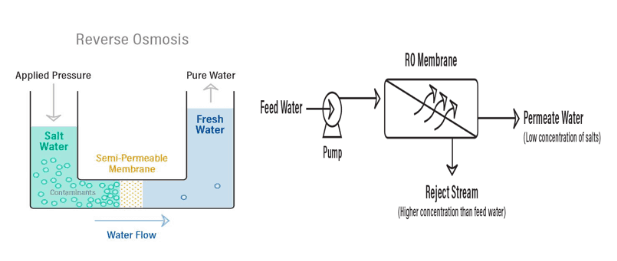UPSC Articles
Science & Technology
Topic: General Studies 2:
- Science and Technology- developments and their applications and effects in everyday life.
Reverse Osmosis (RO) Purifiers – Draft notification by Government
About Reverse Osmosis
- Reverse Osmosis is a technology that is used to remove a large majority of contaminants from water by pushing the water under pressure through a semi-permeable membrane.

Daily Current Affairs IAS | UPSC Prelims and Mains Exam – 10th February 2020
- It works by using a high-pressure pump to increase the pressure on the salt side of the RO and force the water across the semi-permeable RO membrane, leaving around 95% to 99% of dissolved salts behind in the reject stream.
- The amount of pressure required depends on the salt concentration of the feed water. Higher the concentration of salt, higher is the pressure required.
- An RO membrane rejects contaminants based on their size and charge
- Reverse Osmosis is also used to produce water that is suitable for many industrial applications that require demineralized or deionized water
Issues with RO System
- Wastage: RO systems now recover only 20 per cent of water while 80 per cent go waste
- Can remove beneficial mineral: The process can cut the levels of calcium and magnesium, which are vital nutrients.
- Membranes get clogged easily which happens when materials build up on the membrane and slow down the flow of water. Thus it requires constant replacement which increases operational costs
- Not 100% purification capability: BIS standards clearly state that RO system is not recommended for treatment of raw water having Arsenic level above 0.1 mg/l and Fluoride level above 8.0 mg/l.
May 2019 NGT order had stated that
- RO Purifiers should be prohibited where TDS (total dissolved solids) – which covers trace chemicals, certain viruses, bacteria and salts – in water was less than 500 miligram per litre (mg/l)
- It had asked the government to redesign the RO system in a way that treated water would have a minimum 150 mg/l TDS concentration.
- It also stressed on remineralisation to compensate for loss of minerals during RO treatment
- It asked RO manufacturers to increase efficiency of systems to recover 60% of water inputs
Draft notification by the Union Environment Ministry (MoEFCC)
- The notification issued on February 3, 2020 mentions that use of membrane-based water purification system (MWPS), mainly RO purifiers, shall be prohibited where drinking water complies with the Bureau of Indian Standards (BIS).
- Enforcement will largely be the responsibility of CPCB and State Pollution Control Boards (SPCBs), taking water supply agencies on board to certify whether they provide potable drinking water in a particular area as per the prescribed BIS standard.
Concerns with the notification
- The notification does not mention any limits prescribed in NGT order
- The notification implies, these filters are only prohibited if the home gets water supply that conforms to BIS standards for Drinking Water.
- Although several State and city water boards claim BIS standards, the water at homes falls short of the test parameters
- The resort to prohibition (to restrict home filters) may cause consumer apprehension
Conclusion
- The case for restricting people’s choices on the means they employ to ensure potable water is thus weak in view of above concern
- Government’s primary aim should be to persuade authorities to upgrade and supply BIS-standard water at the consumer’s end and it should be done without additional costs.
Do You Know?
- The BIS norms are voluntary for public agencies which supply piped water but are mandatory for bottled water producers.
- The Composite Water Management Index (CWMI) of NITI Aayog says that 70% of water supply is contaminated.
- India is ranked 120th among 122 countries in an NGO, WaterAid’s quality index.
Connecting the dots!
- Nal Se Jal: Government’s mission to ensure piped drinking water to every rural Households by 2024













